The Economic Writings of Sir William Petty is a book with texts, written by William Petty (1623-1687), and published in 1899 by Charles Henry Hull (1864-1936), in two volumes. The Economic Writings were published together with an introduction about the life and work of William Petty, and did also contain Natural and Political Observations upon the Bills of Mortality, by John Graunt.
This edition of the economic texts of William Petty, the scientist, who is often been called the founder of political economy, [1] is used as a reference work ever since its publication. [2]
Apart from the extensive collection of written publications by William Petty (and John Graunt), the general introduction to the life and work of Petty and Graunt, and the short introductions to the separate texts, it also contained the first extensive bibliography of the writings of Petty and Graunt.
Introduction(s) by Charles Henry Hull
The book opens with an 'Introduction' by the editor, Charles Henry Hull, which gives biographic information on Petty and Graunt, and an extensive recapitulation of the debate concerning the authorship of the "Observations upon the Bills of Mortality".
The biography of Petty (p. xiii- xxxiii) is among many other sources, based on some early publications, like the Athenae Oxoniensis by Anthony Wood (published 1691), Petty's will, first published in the Tracts relating chiefly to Ireland (first published 1769), [13] the Brief Lives of John Aubrey, [14] on Petty's History of the Down Survey (published 1851 by Thomas Aiskew Larcom for the Irish Archaeological Society) and on the Life of Sir William Petty 1623 - 1687 by Lord Edmond Fitzmaurice (published 1895).
The second section of the 'Introduction' (p. xxxiv-xxxviii) gives a short biography of John Graunt, the author of the Observations upon the Bills of Mortality (first published 1662).
Hull spends quite some space [15] on a detailed investigation of "the authorship of the Observations upon the Bills of Mortality". There are certain grounds for assigning the authorship of the Observations to William Petty. Some contemporaries of Petty have given rise to the idea that Petty was the author, like John Evelyn, John Aubrey, Edmund Halley and Bishop Gilbert Burnet. But there are also a number of contemporary testimonies in favour of Graunt. In the first place by Petty himself, in two letters to Sir Robert Southwell, but also by Sir Peter Pett. The final conclusion of Hull is that Graunt was definitely the author of the Observations. [16]
After a short section on Petty's letters and other manuscripts, the 'Introduction' gives an overview of the whole body of economic writings of Petty.
The 'Introduction' finishes with two sections on Graunt and the (London) Bills of Mortality.
Most of the separate texts in the Economic Writings also have an introduction by Hull.

Richard Baxter was an English Nonconformist church leader and theologian from Rowton, Shropshire, who has been described as "the chief of English Protestant Schoolmen". He made his reputation in the late 1630s by his ministry at Kidderminster in Worcestershire, when he also began a long and prolific career as theological writer.
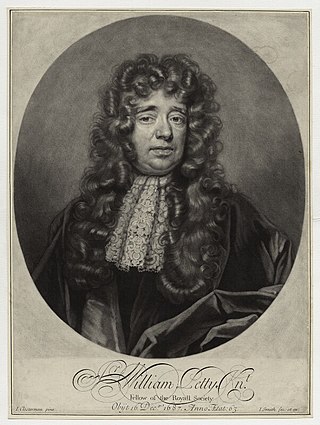
Sir William Petty was an English economist, physician, scientist and philosopher. He first became prominent serving Oliver Cromwell and the Commonwealth in Ireland. He developed efficient methods to survey the land that was to be confiscated and given to Cromwell's soldiers. He also remained a significant figure under King Charles II and King James II, as did many others who had served Cromwell.
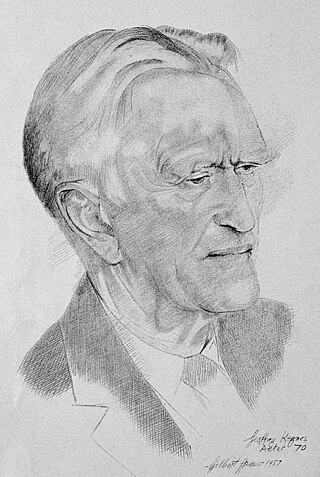
Sir Geoffrey Langdon Keynes was a British surgeon and author. He began his career as a physician in World War I, before becoming a doctor at St Bartholomew's Hospital in London, where he made notable innovations in the fields of blood transfusion and breast cancer surgery. Keynes was also a publishing scholar and bibliographer of English literature and English medical history, focusing primarily on William Blake and William Harvey.
Gregory King was an English officer of arms, engraver, cartographer and statistician.

William Winstanley was an English poet and compiler of biographies.
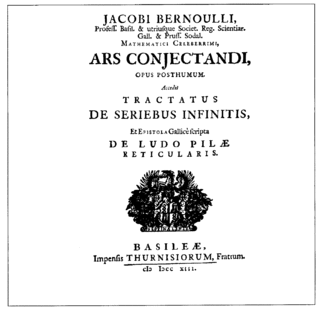
Ars Conjectandi is a book on combinatorics and mathematical probability written by Jacob Bernoulli and published in 1713, eight years after his death, by his nephew, Niklaus Bernoulli. The seminal work consolidated, apart from many combinatorial topics, many central ideas in probability theory, such as the very first version of the law of large numbers: indeed, it is widely regarded as the founding work of that subject. It also addressed problems that today are classified in the twelvefold way and added to the subjects; consequently, it has been dubbed an important historical landmark in not only probability but all combinatorics by a plethora of mathematical historians. The importance of this early work had a large impact on both contemporary and later mathematicians; for example, Abraham de Moivre.
The following is a timeline of probability and statistics.

Robert Hues was an English mathematician and geographer. He attended St. Mary Hall at Oxford, and graduated in 1578. Hues became interested in geography and mathematics, and studied navigation at a school set up by Walter Raleigh. During a trip to Newfoundland, he made observations which caused him to doubt the accepted published values for variations of the compass. Between 1586 and 1588, Hues travelled with Thomas Cavendish on a circumnavigation of the globe, performing astronomical observations and taking the latitudes of places they visited. Beginning in August 1591, Hues and Cavendish again set out on another circumnavigation of the globe. During the voyage, Hues made astronomical observations in the South Atlantic, and continued his observations of the variation of the compass at various latitudes and at the Equator. Cavendish died on the journey in 1592, and Hues returned to England the following year.
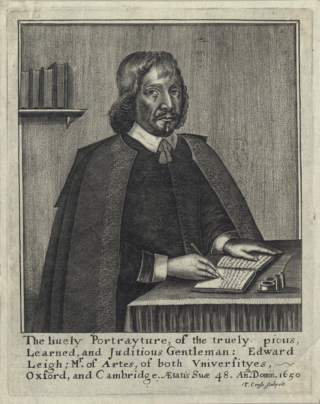
Sir Edward Leigh was an English lay writer, known particularly for his works on religious topics, and a politician who sat in the House of Commons from 1645 to 1648.

Pea soup fog is a very thick and often yellowish, greenish or blackish fog caused by air pollution that contains soot particulates and the poisonous gas sulphur dioxide. This very thick smog occurs in cities and is derived from the smoke given off by the burning of soft coal for home heating and in industrial processes. Smog of this intensity is often lethal to vulnerable people such as the elderly, the very young (infants) and those with respiratory problems. The result of these phenomena was commonly known as a London particular or London fog; in a reversal of the idiom, "London particular" became the name for a thick pea and ham soup.
John Graunt has been regarded as the founder of demography. Graunt was one of the first demographers, and perhaps the first epidemiologist, though by profession he was a haberdasher. He was bankrupted later in life by losses suffered during Great Fire of London and the discrimination he faced following his conversion to Catholicism.
Moral statistics most narrowly refers to numerical data generally considered to be indicative of social pathology in groups of people. Examples include statistics on crimes, illiteracy, suicide, illegitimacy, abortion, divorce, prostitution, and the economic situation sometimes called pauperism in the 19th century.
Jerome Sankey or Hierom Zanchy was an English soldier and politician who sat in the House of Commons at various times between 1654 and 1659. He served in the Parliamentary army during the English Civil War and later served in Ireland.
Charles Henry Hull was an American economist and historian. He worked at Cornell University, in Ithaca, New York. In 1900, he was appointed professor of American History.
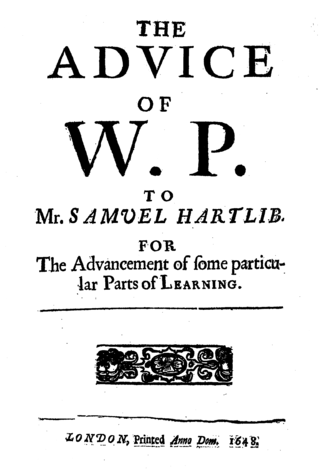
The Advice to Hartlib was a treatise on education, written by Sir William Petty (1623–1687) in 1647 as a letter to Samuel Hartlib. and published in 1647/8. It was the first printed work by Petty and covers a total of 31 pages.

A Declaration Concerning the newly invented Art of Double Writing was a pamphlet of 6 leaves, written by Sir William Petty (1623–1687) and first published in 1648. It contained information regarding his invention of the "Art of Double Writing", especially a claim for patent rights. It did not contain any information on what his invention exactly was.

The Proceedings between Sankey and Petty is a pamphlet that contains a summary of the controversy that arose between Sir Hierom Sankey and Sir William Petty in the aftermath of the Down Survey. Sankey accused Petty of bribery and fraud. One of the ways in which Petty answered to this accusations was by this pamphlet, that was published in print by Petty in 1659 and covers a total of ten pages.

The Life of Sir William Petty 1623–1687 is a book, written by Lord Edmond Fitzmaurice, and published in 1895. It is a biography of Sir William Petty, the 17th-century scientist, known for his inventions, his charting of large parts of Ireland, in the Down Survey, and his publications on many different topics, like "political arithmetic" and political economy.

Reflections upon some Persons and Things in Ireland is an essay, written by Sir William Petty (1620-1687) and published in 1660. It contains a summary of the work carried out by Petty in the so-called Down Survey, and especially a defense against the critics that were cast upon him afterwards. It was a further elaboration of the short pamphlet, titled The Proceedings between Sankey and Petty, that was published by Petty the year before.

"Petty's Place in the History of Economic Theory" is an academic article, written by Charles Henry Hull and published in The Quarterly Journal of Economics in 1900.















